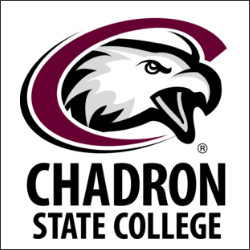![]()
By Tena Cook

Edward Welsh, a 2004 graduate of Chadron State College, was a guest speaker at Agate Fossil Beds National Monument this summer. Welsh, a park ranger at Badlands National Park since 2012, presented about a recently discovered genus of a small, hornless deer that he and his colleague Mattison Shreero researched.
Genus is the second tier of the taxonomical hierarchy used to classify organisms. The new genus is part of families from the Badlands, approximately 32 million years ago, and Agate Fossil Beds, roughly 20 million years ago. The two paleontologists named the animal Santuccimeryx in honor of their colleague and friend, Vince Santucci, Senior Paleontologist for the National Park Service. Santucci’s first National Park Service job was with Badlands National Park.
Some of Welsh’s other discoveries include a new species of a cat-like carnivore and locating one of only two fossilized insects discovered in the White River Badlands.
Welsh is interested in relocating historic field expeditions and finding some of the area’s first iconic fossil sites. One site he wants to explore predates the first discovery of dinosaurs in the Western Hemisphere, which was established just a few years after the term dinosaur was coined.
“I’ve always been interested in animals, living and extinct. In high school, I thought about a career in wildlife biology or zoology, but realized that extinct animals were way more bizarre, interesting, and posed more questions to solve. Oddities have always appealed to me,” Welsh said.
Following graduation from CSC, Welsh worked for the Forest Service Office in Chadron for one year before enrolling in graduate school at South Dakota School of Mines and Technology in Rapid City, South Dakota.
Toward the end of his graduate program, Welsh accepted a position at SWCA Environmental Consulting, where he worked on multiple monitoring and mitigation projects for pipelines and engaged with seismic studies.
Welsh recalls a summer trip to Big Bend National Park with a colleague from South Dakota School of Mines, where they engaged in fieldwork at a dinosaur site. Towards the end of the trip, Welsh discovered a stash of fossilized eggshells, which led to additional visits to the site and motivated him to complete his first published work.
His initial position was as a seasonal employee, but he had the opportunity to teach as an adjunct professor for the University of Wisconsin during the park’s offseason. He taught General Physical Geology for freshmen and a comprehensive Paleontology course for seniors. Since then, Welsh has become the park’s Educational Specialist.
While at CSC, Welsh was a part of the Geosciences Program and the Natural Sciences Club.
“These clubs helped expand my natural knowledge repertoire that serves well with the National Park Service,” Welsh said.
Having access to areas around CSC, Welsh has become an expert with local fossils.
“My familiarity with geologic and palaeontologic resources in the Chadron-Crawford area ties in with the resources at Badlands National Park, and this has carved a pretty unique niche for myself as one of the few experts of these local fossils from the middle of the Age of Mammals,” Welsh said.
Welsh enjoyed his time at Chadron State College. He appreciated his friends, classmates, professors, and opportunities. Welsh recalls mapping more than 300 tortoise fossils at Toadstool Geologic Park as part of a research project for the Natural Sciences Club.
Throughout Welsh’s work, he has taken school aged children on field trips to explore fossil sites. One student, a fifth grader from Wanblee, South Dakota, found a saber-toothed nimravid jaw. Students from Manhattan, under the supervision of Welsh, helped lead the discovery of an early dog fossil that is currently being studied on how dogs first diversified in North America.
